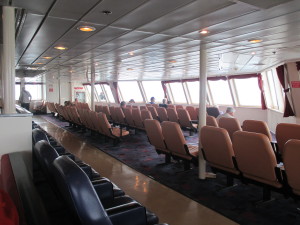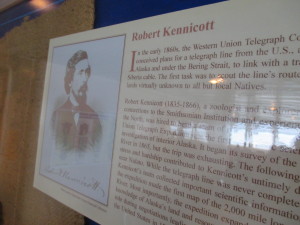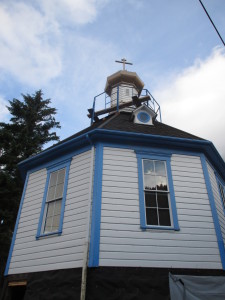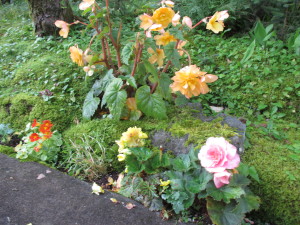Back aboard the M/V Kennicott, we’re enroute to Juneau. Traveling on this well-equipped ferry is delightful; it offers all the amenities you’d need for a relaxing and scenic tour of coastal Alaska. The M/V Kennicott boasts five spacious decks. Vehicles and pets fill up the lowest car deck and the cabin deck sits atop it. The boat deck has both a forward and rear lounge complete with cushioned booths and comfortable viewing chairs.

A small theater in the rear of the forward lounge features films pertaining to Alaska’s history and culture. Yesterday, we viewed “Spirit of the Wind,” a moving film about George Attla, an Athabscan man who overcame a physical limitation to win the Anchorage Rondy, a dog sled competition. On hand to introduce the film and answer questions, was its director, Ralph Little; Little plans to sell his film to ferries and cruise lines. (It’s currently available at the Alaska Native Heritage Center). The directing, authentic acting, scenery, and music make this a truly inspirational film.
Sandwiched between the lounges are a restaurant with a full service menu, a cocktail lounge, a gift shop, and a play area for kids. A sundeck and solarium deck for enclosed camping area are upstairs. The M/V Kennicott was named after Robert Kennicott (1835-1866), a zoologist and explorer with connections to the Smithsonian Institution and experience in the North. Kennicott was hired to head a team of naturalists that would survey interior Alaska for the Western Union Telegraph Expedition. This was the first systematic scientific investigation of interior Alaska. Kennicott and his men began its survey of the Yukon River in 1865, but the trip was exhausting. The following year, stress and hardship led to Kennicott’s untimely death near Nulato. although the telegraph line–one that would link Alaska with Siberia under the Bering Strait–was never completed, Kennicott’s team collected important scientific information and they made the first map of the 2,000 mile long Yukon River. Most importantly, the expedition expanded people’s knowledge of Alaska’s land and resources; this knowledge played a crucial role during negotiations leading to the purchase of Alaska by the U.S. in 1867. Also named for Robert Kennicott, are a glacier which flows 27 miles from Mont Blackburn to McCarthy Creek in the Wrangell Mountains–a source of nine glaciers. The Kennicott mine, also bearing his name, was a valuable copper mine in the early and mid- 1900s.

Fellow travelers are also interested in the spectacular scenery Alaska offers. The bow deck is often full of travelers snapping pictures of Orca whale pods, sunsets, and tree covered mountains. We’ve met some very nice folks: Sue and Harold Johnson from Sun City West, Arizona, have shared meals with us in the ship’s restaurant. Harold is an excellent photographer and Sue, an accomplished quilter. Another interesting traveler, RG Smith, of Reno Nevade is aboard with his FJ Cruiser; he plans to meet his brother in Anchorage and be the first FJ Cruiser owner to post a picture of their vehicle in the Arctic Circle. We enjoyed meeting Dennis and Deb from Manhattan, Montana as well.
This morning aboard the ferry started out foggy and rainy. The Ketchican to Juneau route takes us through Clarence Strait, Sumner Strait, and Chatham Strait. The outside temperature is getting noticeably chillier, and we’ve discarded our t-shirts and cargo pants for sweatshirts and jeans. We’ve also ditched the shelter of Vancouver Island and the Queen Charlotte Islands. We’ll be traveling through the Alexander Archipelago, a 400-mile long maze of 1,000 islands with a 30-mile wide sliver of mainland. This region is also known as the Southeast Alaska Panhandle. As the fog cleared, we viewed lush green forests–among them spruce, hemlock, cedar, and fir. A few mountains were snowcapped. Pods of whales swam past us; they’re difficult to photograph because they surface only briefly.
Our stop in Juneau came earlier than expected: 6:30 a.m. Juneau was named after Joe Juneau, who along with his comrade Richard Harris, discovered gold here some 130 years ago (1880). Today, Juneau boasts a population of some 32,000 and is a thriving state capital. In fact, Juneau is the only U.S. capital to border another country.
Our taxi driver gave us a lift past the airport, (we dropped off a father who was going to rent a car and show his teenage son around the state) and called our attention to the bald eagles perched atop the road’s street lights. We saw the Mendenhall glacier, a salmon hatchery, and the looming Douglas Island, accessible only by bridge over the Gastenau Channel.
Our original plan was to hike the Perseverance trail, a trail that shared evidence of early mining camps, but when we realized the distance from the trail to downtown, Juneau, we revised our plan–instead, exploring downtown Juneau. On Gold Street, we photographed the St. Nicholas Russian Orthodox Church. This tiny, unique house of worship is octagonal in shape and has an onion-domed roof. The church was built in 1894 at the request of the Juneau Tlingit chief, Ishkhanalykh. The church is the oldest original Orthodox church in Southeast Alaska.

Juneau has many shops with locally made arts and crafts. Some store fronts are colorfully decorated with totem poles. We shopped at Mad Hatter’s Emporium owned by “Head Hooligan” Jayle Kent. there, we purchased some Russian stack- doll souvenirs and glow-in-the-dark earrings.
The Juneau-Douglas City Museum features a variety of exhibits relating to Juneau’s local history, art, and culture, including a 500-some year old Native basket fish trap and a display explaining the history of skiing. We viewed a photo series titled, “The Empty chair” which told the story of Juneau’s Japanese and Japanese-Americans who were forcefully removed to isolated federal internment camps during World War II. The display also credits Juneau residents for their support and welcoming responses to those Japanese people.

Juneau boasts several well-designed state government buildings. The Stewart Legislative Office building was constructed in 1928. Alaska’s state capitol houses the Governor’s office and legislature. The State Office building houses offices for state employees.
Following are our “Juneau Observations”: Most homes in Juneau have metal–not shingle–roofs. The metal is more durable and withstands the high moisture level in this region. One shingled roof we observed had heavy layers of moss on it. More succulent flowers can be seen in Juneau flower gardens. Juneau is welcoming to cruise ships. During our morning stop in Juneau, we counted four cruise ships in port. The steep hillsides are covered with Sitka Spruce–straight-top and sharp-tipped needles. Juneau is in the Tongass National Forest which covers some 17 million acres, including nearly all of Alaska’s Inside Passage. the Tongass is a temperate rainforest. Juneau was the site of the first U.S. civil rights march in 1945. Tlingit Elizabeth Peratrovich led a march for equality. We saw Lake Auke; “auke” is a Tlingit word meaning “lake.”
